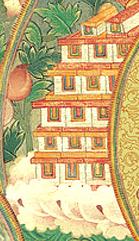Sutra: Difference between revisions
No edit summary |
mNo edit summary |
||
| (26 intermediate revisions by 8 users not shown) | |||
| Line 1: | Line 1: | ||
'''Sutra''' | [[Image:Dharma.JPG|frame|Texts from the [[Longchen Nyingtik]] [[Field of merit]]]] | ||
'''Sutra''' (Skt. ''sūtra''; Tib. [[མདོ་]], ''do'', [[Wyl.]] ''mdo'') — the Sanskrit literally means ‘something that was heard from someone else’ and usually connotes ‘a discourse’. | |||
*It refers to the discourses that the [[Buddha]] gave. | *It refers to the discourses that the [[Buddha]] gave. | ||
*‘Sutra’, as distinct from ‘[[tantra]]’. The entire teachings of the Buddha can be distinguished as either sutra or tantra. | *‘Sutra’, as distinct from ‘[[tantra]]’. The entire teachings of the Buddha can be distinguished as either sutra or tantra. | ||
* One of the [[three pitakas|three collections]] of the Buddha’s teachings: [[Vinaya]], Sutra and [[Abhidharma]]. Here, the | * One of the [[three pitakas|three collections]] of the Buddha’s teachings: [[Vinaya]], Sutra (Tib. [[མདོ་སྡེ་]], ''do de'') and [[Abhidharma]]. Here, the sutras are related primarily to [[meditation]], and are said to be the remedy for the poison of anger and aggression. | ||
==Subdivisions of the Sutra Collection== | |||
The sutra collection of the [[Kangyur]] contains 398 texts categorised into five sections: | |||
*The Perfection of Wisdom (Skt. ''[[Prajnaparamita|Prajñāpāramitā]]'') section ([[Toh]] 8-30) | |||
*The [[Thirteen late translated sutras]] section (Toh 31-43) | |||
*The Ornaments of the Buddhas (Skt. ''[[Avatamsaka|Buddhāvataṃsaka]]'') section (Toh 44) | |||
*The Heap of Jewels (Skt. ''[[Ratnakuta|Ratnakūṭa]]'') section (Toh 45-93) | |||
*The [[General Sutra]] section (Toh 94-359) | |||
==Types of Sutra== | |||
There are three types of sutras: | |||
#sutras spoken directly by the Buddha (ཞལ་ནས་གསུངས་པའི་བཀའ་, ''zhal nas gsungs pa'i bka' '') | |||
#sutras spoken through the blessing of the Buddha (ཡིན་གྱིས་བརླབས་པའི་བཀའ་, ''byin gyis brlabs pa'i bka' '') | |||
#sutras spoken through mandate (རྗེས་སུ་གནང་བའི་བཀའ་, ''rjes su gnang ba'i bka' '') | |||
During the forty-five years the Buddha taught, he granted thousands of sutra teachings to his disciples. Other teachings, directly inspired by the blessing of the Buddha and spoken by the great [[bodhisattvas]], are also considered sutras. The most famous example of such a sutra is the [[Heart Sutra]], which is recited by the bodhisattva [[Avalokiteshvara]]. Sutras spoken through mandate are those which the Buddha instructed his followers to compile from the teachings they had heard.<ref>''Ways of Enlightenment'', Dharma Publishing pages 31-32</ref> | |||
==References== | |||
<small><references/></small> | |||
==External Links== | |||
*{{84000|https://read.84000.co/section/O1JC114941JC12924.html|Discourses Section of the Kangyur}} | |||
[[Category:Key Terms]] | [[Category:Key Terms]] | ||
[[Category:Sanskrit Terms]] | |||
[[Category:Texts]] | [[Category:Texts]] | ||
[[Category:Sutras| ]] | |||
[[Category:Canon]] | |||
[[Category:Kangyur]] | |||
[[Category:Literary Genres]] | |||
Latest revision as of 08:39, 14 September 2023

Sutra (Skt. sūtra; Tib. མདོ་, do, Wyl. mdo) — the Sanskrit literally means ‘something that was heard from someone else’ and usually connotes ‘a discourse’.
- It refers to the discourses that the Buddha gave.
- ‘Sutra’, as distinct from ‘tantra’. The entire teachings of the Buddha can be distinguished as either sutra or tantra.
- One of the three collections of the Buddha’s teachings: Vinaya, Sutra (Tib. མདོ་སྡེ་, do de) and Abhidharma. Here, the sutras are related primarily to meditation, and are said to be the remedy for the poison of anger and aggression.
Subdivisions of the Sutra Collection
The sutra collection of the Kangyur contains 398 texts categorised into five sections:
- The Perfection of Wisdom (Skt. Prajñāpāramitā) section (Toh 8-30)
- The Thirteen late translated sutras section (Toh 31-43)
- The Ornaments of the Buddhas (Skt. Buddhāvataṃsaka) section (Toh 44)
- The Heap of Jewels (Skt. Ratnakūṭa) section (Toh 45-93)
- The General Sutra section (Toh 94-359)
Types of Sutra
There are three types of sutras:
- sutras spoken directly by the Buddha (ཞལ་ནས་གསུངས་པའི་བཀའ་, zhal nas gsungs pa'i bka' )
- sutras spoken through the blessing of the Buddha (ཡིན་གྱིས་བརླབས་པའི་བཀའ་, byin gyis brlabs pa'i bka' )
- sutras spoken through mandate (རྗེས་སུ་གནང་བའི་བཀའ་, rjes su gnang ba'i bka' )
During the forty-five years the Buddha taught, he granted thousands of sutra teachings to his disciples. Other teachings, directly inspired by the blessing of the Buddha and spoken by the great bodhisattvas, are also considered sutras. The most famous example of such a sutra is the Heart Sutra, which is recited by the bodhisattva Avalokiteshvara. Sutras spoken through mandate are those which the Buddha instructed his followers to compile from the teachings they had heard.[1]
References
- ↑ Ways of Enlightenment, Dharma Publishing pages 31-32